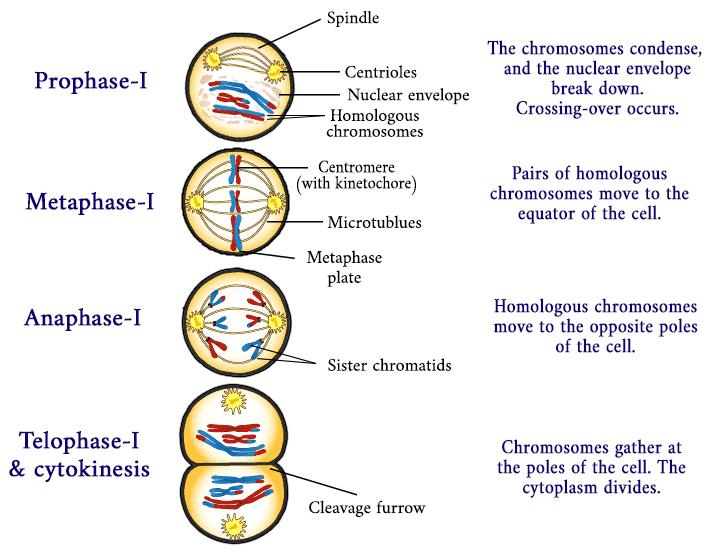Answer
394.2k+ views
Hint: Meiosis is a process in which a single cell divides twice to produce four cells that contain half of the original amount of genetic information. The longest phase is the one in which recombination occurs.
Complete answer:
Prophase I is the longest phase of meiosis, usually taking up 90 percent of the time for the two divisions. The five prophase stages include separate processes such as condensation (Leptotene) , pairing (Zygotene), recombination (Pachytene), coiling (Diplotene), and recondensation (Diakinesis).
One can divide meiosis into nine stages. These are split between the first division of the cell (meiosis I) and the second division of the cell (meiosis II). The nine stages of meiosis are Interphase, Prophase I, Metaphase I, Anaphase I, Telophase I, Prophase II, Metaphase II, Anaphase II, and Telophase II. It is classified into 5 substages based on Leptotene, Zygotene, Pachytene, Diplotene, and Diakinesis.
Additional information:
The copied chromosomes condense in prophase I into X- shaped structures which can easily be seen under a microscope. Each chromosome consists of two sister chromatids that contain identical genetic material. The chromosome pairs may then swap bits of DNA in a process called recombination or crossing over. At the end of Prophase I, the membrane within the cell around the nucleus dissolves, releasing the chromosomes.

So the correct answer is ‘prophase I.’
Note:
- Homologous chromosomes pair up during prophase I and share genetic information (homologous recombination) . Sometimes this contributes to chromosomal crossover.
- The meiotic spindle, composed of microtubules and other proteins, spreads between the centrioles across the cell.
Complete answer:
Prophase I is the longest phase of meiosis, usually taking up 90 percent of the time for the two divisions. The five prophase stages include separate processes such as condensation (Leptotene) , pairing (Zygotene), recombination (Pachytene), coiling (Diplotene), and recondensation (Diakinesis).
One can divide meiosis into nine stages. These are split between the first division of the cell (meiosis I) and the second division of the cell (meiosis II). The nine stages of meiosis are Interphase, Prophase I, Metaphase I, Anaphase I, Telophase I, Prophase II, Metaphase II, Anaphase II, and Telophase II. It is classified into 5 substages based on Leptotene, Zygotene, Pachytene, Diplotene, and Diakinesis.
Additional information:
The copied chromosomes condense in prophase I into X- shaped structures which can easily be seen under a microscope. Each chromosome consists of two sister chromatids that contain identical genetic material. The chromosome pairs may then swap bits of DNA in a process called recombination or crossing over. At the end of Prophase I, the membrane within the cell around the nucleus dissolves, releasing the chromosomes.

So the correct answer is ‘prophase I.’
Note:
- Homologous chromosomes pair up during prophase I and share genetic information (homologous recombination) . Sometimes this contributes to chromosomal crossover.
- The meiotic spindle, composed of microtubules and other proteins, spreads between the centrioles across the cell.
Recently Updated Pages
How do you arrange NH4 + BF3 H2O C2H2 in increasing class 11 chemistry CBSE

Is H mCT and q mCT the same thing If so which is more class 11 chemistry CBSE

What are the possible quantum number for the last outermost class 11 chemistry CBSE

Is C2 paramagnetic or diamagnetic class 11 chemistry CBSE

What happens when entropy reaches maximum class 11 chemistry JEE_Main

Calculate the volume occupied by 88 gram of CO2 at class 11 chemistry CBSE

Trending doubts
Difference between Prokaryotic cell and Eukaryotic class 11 biology CBSE

Difference Between Plant Cell and Animal Cell

Select the word that is correctly spelled a Twelveth class 10 english CBSE

Fill the blanks with the suitable prepositions 1 The class 9 english CBSE

What is the z value for a 90 95 and 99 percent confidence class 11 maths CBSE

Give 10 examples for herbs , shrubs , climbers , creepers

What organs are located on the left side of your body class 11 biology CBSE

What is BLO What is the full form of BLO class 8 social science CBSE

Change the following sentences into negative and interrogative class 10 english CBSE



